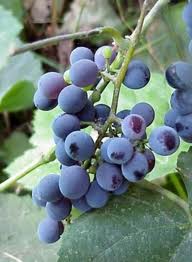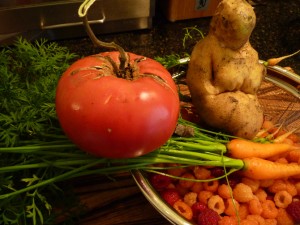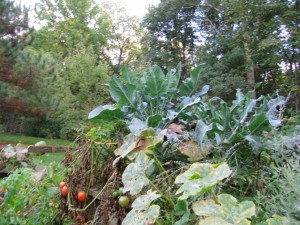Lughnasa Waning Harvest Moon
Today we moved from conjecture to certainty. The top person at English Gate Academy, Ahmed, e-mailed Mark and said he would write a personal note to the Saudi Embassy asking them to speed Mark’s visa application along.
His papers cleared the Saudi Cultural Mission today and are at the Embassy so it should be a matter of days now before he has his passport back with his Saudi work visa in place. At that point English Gate will send him an e-ticket. He’ll pack and I’ll take him out the same airport where I picked him up in April, just as spring began to try breaking through the long and persistent grip of our long winter.
It’s been a long and not always straightforward journey for Mark, but he’s got his head and heart in better alignment plus he pulled off the difficult in this US economy; he found a good paying job, better pay than he’s ever made.
We spent the morning harvesting wild  grapes, talking through the vine. With the freeze tonight we had to get the sensitive crops inside. Kate picked the tomatoes that will ripen over the next few weeks and a small bucket of raspberries while Mark and I picked a rose cone full of the small purple grapes.
grapes, talking through the vine. With the freeze tonight we had to get the sensitive crops inside. Kate picked the tomatoes that will ripen over the next few weeks and a small bucket of raspberries while Mark and I picked a rose cone full of the small purple grapes.
That means Kate the jelly and jam maker will appear, working with her alchemical apparatus to strain the grapes, add the sugar and pectin and can the result. Wild grape jelly has a special and tangy taste. Great for those cold winter breakfasts.

 Fresh ingredients are key to Italian, Chinese and vegetarian cooking so a garden facilitates those cuisines, at least during the harvest system. Our best meals of the summer happen in September.
Fresh ingredients are key to Italian, Chinese and vegetarian cooking so a garden facilitates those cuisines, at least during the harvest system. Our best meals of the summer happen in September. carrots I have in the ground awaiting the frost, I discovered golden raspberries large as my thumb. A real treat at this late stage in the year. They await the vanilla ice cream I’m going to buy when I go to the grocery store.
carrots I have in the ground awaiting the frost, I discovered golden raspberries large as my thumb. A real treat at this late stage in the year. They await the vanilla ice cream I’m going to buy when I go to the grocery store.